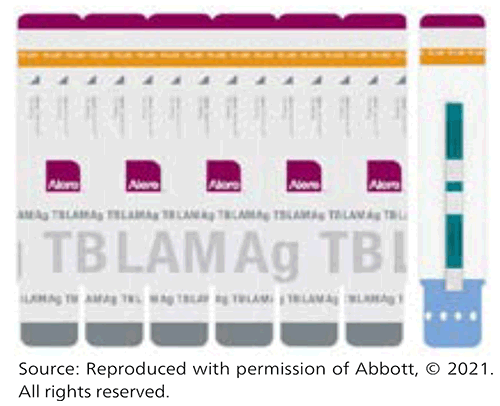Liens transversaux de livre pour 2.3.2 Urine LF-LAM
The urine LF-LAM is an immunocapture assay based on the detection of the mycobacterial LAM antigen in urine; it is a potential point-of-care test for certain populations being evaluated for TB. Although the assay lacks sensitivity, it can be used as a fast, bedside, rule-in test for HIV-positive individuals, especially in urgent cases where a rapid TB diagnosis is critical for the person’s survival. The Alere Determine TB LAM Ag is currently the only commercially available urine LF-LAM test endorsed by WHO. The detection of mycobacterial LAM antigen in urine does not provide any information on drug resistance. A document is available addressing practical considerations for the implementation of the LF-LAM (19).

WHO recommends using urine LF-LAM in the following situations (7):
- In inpatient settings, WHO recommends using LF-LAM to assist in the diagnosis of active TB in HIV-positive adults, adolescents and children:
- with signs and symptoms of TB (pulmonary or extrapulmonary);
- with advanced HIV disease;
- who are seriously ill; or
- who have a CD4 cell count of less than 200 cells/mm³ , irrespective of signs and symptoms of TB.
- In outpatient settings, WHO suggests using LF-LAM to assist in the diagnosis of active TB in HIV-positive adults, adolescents and children who:
- have signs and symptoms of TB (pulmonary or extrapulmonary);
- are seriously ill; or
- have a CD4 cell count of less than 100 cells/mm³ , irrespective of signs and symptoms of TB.
- In outpatient settings, WHO recommends against using LF-LAM to assist in the diagnosis of active TB in HIV-positive adults, adolescents and children:
- who have not been assessed for TB symptoms; or
- without TB symptoms and with an unknown CD4 cell count or with a CD4 cell count greater than 100 cells/mm³.
Notes:
- For their initial diagnostic test, anyone with signs and symptoms of pulmonary TB who is capable of producing sputum should have at least one sputum specimen submitted for an mWRD assay. This includes children and adolescents living with HIV who can provide a sputum sample. LF-LAM results (test time <25 minutes) are likely to be available before mWRD results; hence, treatment decisions should be based on the LF-LAM result while awaiting the results of other diagnostic tests.
- LF-LAM may be used to assist in the diagnosis of TB but it should not be used as a triage test.
 Retour
Retour